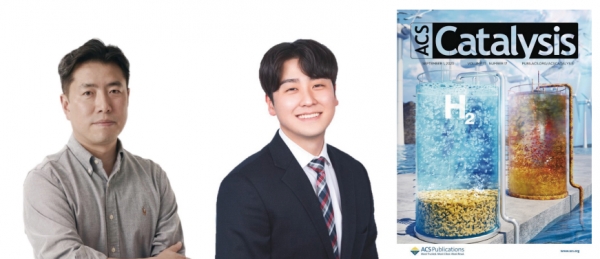
The term “Sherpa” commonly denotes the guides who assist climbers on Mount Everest. Similarly, a research team led by Professor Yong-Tae Kim (MSE) and Ph.D. Candidate Kyu-Su Kim published a paper addressing the unsolved challenge of developing electrocatalysts for water electrolysis, which graced the cover of the academic journal, ACS Catalysis.
Water electrolysis is an eco-friendly technique for extracting hydrogen from water. Nevertheless, the process is economically impractical due to the requirement of precious metal catalysts. Thus, in academia, extensive efforts are underway to overcome this limitation by creating new catalysts in alloy form with other metals.
The primary metals for water electrolysis catalysts are iridium, ruthenium, and osmium. Iridium, though highly stable, exhibits low activity and comes at a high cost. On the other hand, ruthenium boasts excellent activity and is more cost-effective than iridium but lacks stability. Osmium tends to dissolve under electrochemical environment, resulting in a porous structure with a large surface area, enhancing the catalyst’s activity.
The team initially developed a catalyst using two metals: iridium and ruthenium. This catalyst retained the favorable characteristics of each metal, leading to increased activity and stability. Additionally, the catalyst containing osmium displayed high activity due to the enlarged surface area resulting from the formation of a porous structure, while maintaining the properties of iridium or ruthenium.
Subsequently, the team fashioned a catalyst incorporating all three metals. While this led to a modest increase in activity, the structure of iridium and ruthenium rapidly collapsed during the osmium dissolution process, resulting in a significant decrease in stability. In this combination, the outstanding properties of each metal were not preserved, leading deteriorated performance.
In light of these findings, the research team proposed a direction for catalyst research. To develop a catalyst that excels in both activity and stability, an indicator capable of evaluating both simultaneously must be employed. In 2017, the team pioneered the world’s first comprehensive metric, considering both activity and stability, and published it in an international academic journal, which was also utilized in this study.
Furthermore, the research team must ensure that the exceptional properties persist even after the porous structure forms to expand the catalyst’s surface area. Careful selection of candidates that can synergize when alloyed with other metals is also crucial. This study holds significance not in presenting specific achievements like the development of new catalysts, but rather in providing instances of failure, thereby deriving considerations for catalyst design.
Prof. Kim, leading the research, stated, “This research marks not the end, but the beginning,” and expressed his ambition, “Building on this, we will persist in our research to develop an efficient water electrolysis catalyst.”
Meanwhile, this research was supported by Future Materials Discovery Project through the National Research Foundation of Korea (NRF).


